2012 Peugeot 3008 Hybrid 4 ECO mode
[x] Cancel search: ECO modePage 110 of 284
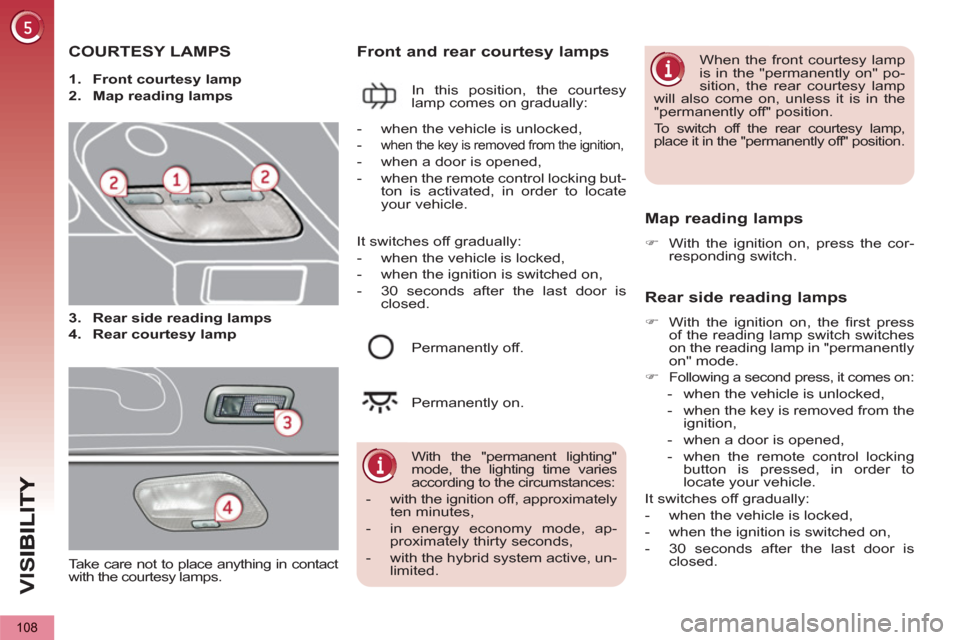
VIS
108
COURTESY LAMPS
1.
Front courtesy lamp
2.
Map reading lamps
Front and rear courtesy lamps
In this position, the courtesy
lamp comes on gradually:
Map reading lamps
�)
With the ignition on, press the cor-
responding switch.
With the "permanent lighting"
mode, the lighting time varies
according to the circumstances:
- with the ignition off, approximately
ten minutes,
- in energy economy mode, ap-
proximately thirty seconds,
- with the hybrid system active, un-
limited.
- when the vehicle is unlocked,
-
when the key is removed from the ignition,
- when a door is opened,
- when the remote control locking but-
ton is activated, in order to locate
your vehicle.
Permanently off.
Permanently on.
When the front courtesy lamp
is in the "permanently on" po-
sition, the rear courtesy lamp
will also come on, unless it is in the
"permanently off" position.
To switch off the rear courtesy lamp,
place it in the "permanently off" position.
Rear side reading lamps
�)
With the ignition on, the fi rst press
of the reading lamp switch switches
on the reading lamp in "permanently
on" mode.
�)
Following a second press, it comes on:
- when the vehicle is unlocked,
- when the key is removed from the
ignition,
- when a door is opened,
- when the remote control locking
button is pressed, in order to
locate your vehicle.
It switches off gradually:
- when the vehicle is locked,
- when the ignition is switched on,
- 30 seconds after the last door is
closed.
It switches off gradually:
- when the vehicle is locked,
- when the ignition is switched on,
- 30 seconds after the last door is
closed.
3.
Rear side reading lamps
4.
Rear courtesy lamp
Take care not to place anything in contact
with the courtesy lamps.
Page 112 of 284
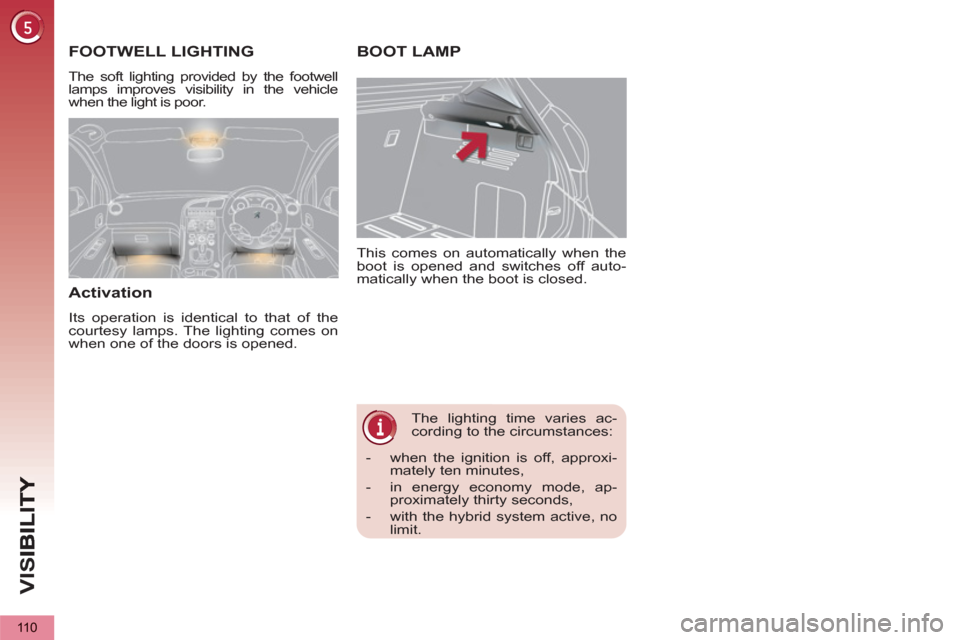
VIS
110
The lighting time varies ac-
cording to the circumstances: This comes on automatically when the
boot is opened and switches off auto-
matically when the boot is closed.
BOOT LAMP FOOTWELL LIGHTING
The soft lighting provided by the footwell
lamps improves visibility in the vehicle
when the light is poor.
Activation
Its operation is identical to that of the
courtesy lamps. The lighting comes on
when one of the doors is opened.
- when the ignition is off, approxi-
mately ten minutes,
- in energy economy mode, ap-
proximately thirty seconds,
- with the hybrid system active, no
limit.
Page 135 of 284
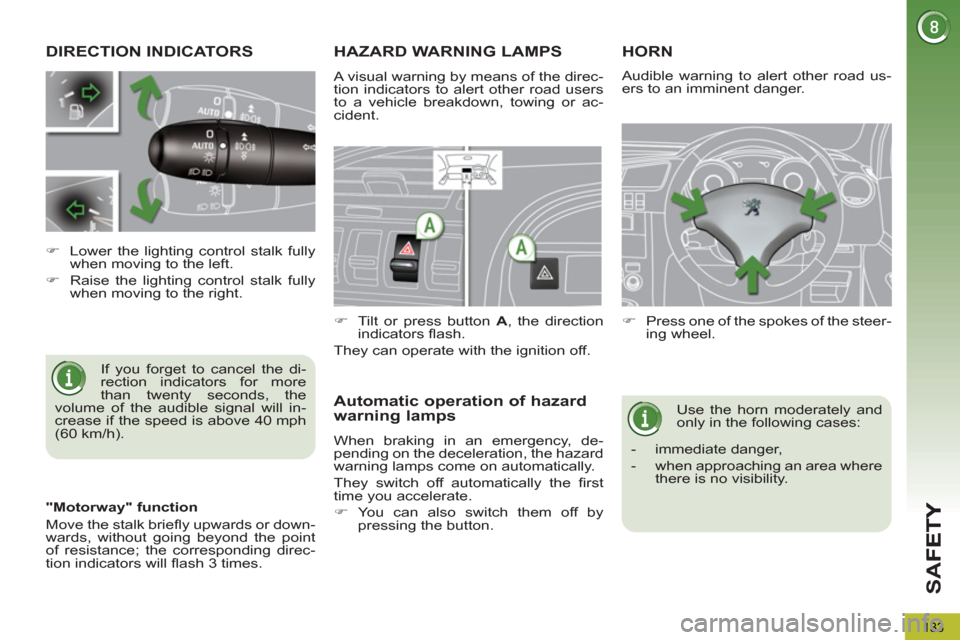
SA
F
133
DIRECTION INDICATORS
If you forget to cancel the di-
rection indicators for more
than twenty seconds, the
volume of the audible signal will in-
crease if the speed is above 40 mph
(60 km/h).
�)
Lower the lighting control stalk fully
when moving to the left.
�)
Raise the lighting control stalk fully
when moving to the right.
HAZARD WARNING LAMPS
A visual warning by means of the direc-
tion indicators to alert other road users
to a vehicle breakdown, towing or ac-
cident.
�)
Tilt or press button A
, the direction
indicators fl ash.
They can operate with the ignition off.
Automatic operation of hazard
warning lamps
When braking in an emergency, de-
pending on the deceleration, the hazard
warning lamps come on automatically.
They switch off automatically the fi rst
time you accelerate.
�)
You can also switch them off by
pressing the button.
HORN
�)
Press one of the spokes of the steer-
ing wheel.
Use the horn moderately and
only in the following cases:
- immediate danger,
- when approaching an area where
there is no visibility.
Audible warning to alert other road us-
ers to an imminent danger.
"Motorway" function
Move the stalk briefl y upwards or down-
wards, without going beyond the point
of resistance; the corresponding direc-
tion indicators will fl ash 3 times.
Page 145 of 284
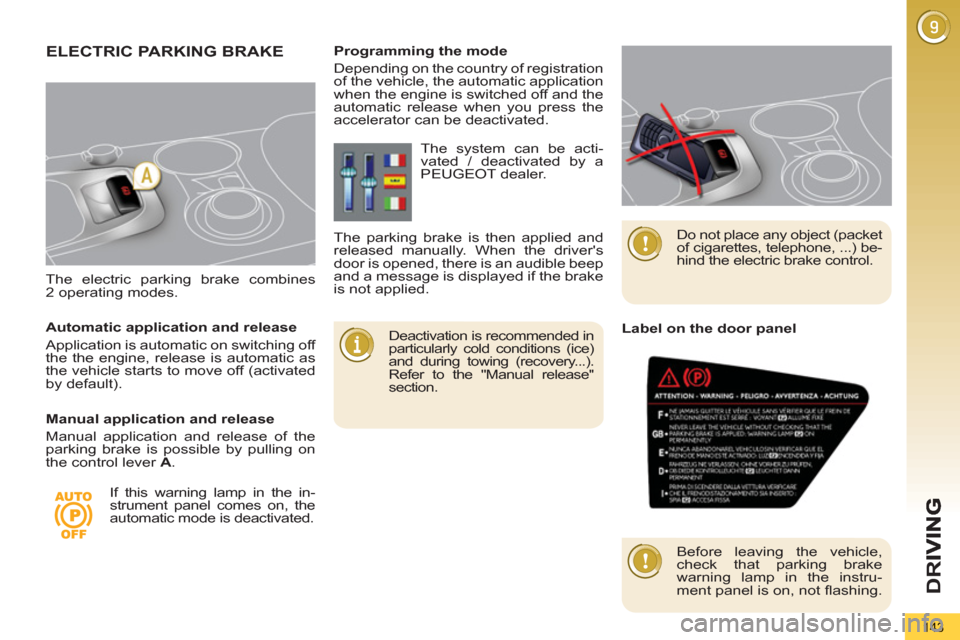
D
R
143
The electric parking brake combines
2 operating modes.
ELECTRIC PARKING BRAKE
Deactivation is recommended in
particularly cold conditions (ice)
and during towing (recovery...).
Refer to the "Manual release"
section.
Programming the mode
Depending on the country of registration
of the vehicle, the automatic application
when the engine is switched off and the
automatic release when you press the
accelerator can be deactivated.
If this warning lamp in the in-
strument panel comes on, the
automatic mode is deactivated. The system can be acti-
vated / deactivated by a
PEUGEOT dealer.
The parking brake is then applied and
released manually. When the driver's
door is opened, there is an audible beep
and a message is displayed if the brake
is not applied.
Do not place any object (packet
of cigarettes, telephone, ...) be-
hind the electric brake control.
Automatic application and release
Application is automatic on switching off
the the engine, release is automatic as
the vehicle starts to move off (activated
by default).
Manual application and release
Manual application and release of the
parking brake is possible by pulling on
the control lever A
.
Label on the door panel
Before leaving the vehicle,
check that parking brake
warning lamp in the instru-
ment panel is on, not fl ashing.
Page 156 of 284
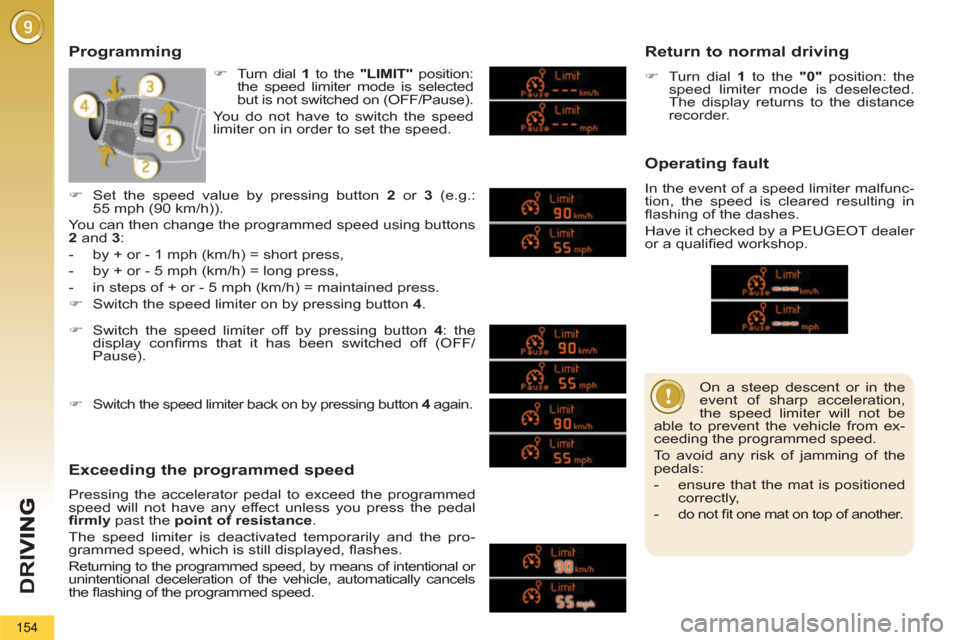
D
R
I
154
On a steep descent or in the
event of sharp acceleration,
the speed limiter will not be
able to prevent the vehicle from ex-
ceeding the programmed speed.
To avoid any risk of jamming of the
pedals:
- ensure that the mat is positioned
correctly,
- do not fi t one mat on top of another.
Programming
Exceeding the programmed speed
Pressing the accelerator pedal to exceed the programmed
speed will not have any effect unless you press the pedal
fi rmly
past the point of resistance
.
The speed limiter is deactivated temporarily and the pro-
grammed speed, which is still displayed, fl ashes.
Returning to the programmed speed, by means of intentional or
unintentional deceleration of the vehicle, automatically cancels
the fl ashing of the programmed speed.
Return to normal driving
�)
Turn dial 1
to the "0"
position: the
speed limiter mode is deselected.
The display returns to the distance
recorder.
Operating fault
In the event of a speed limiter malfunc-
tion, the speed is cleared resulting in
fl ashing of the dashes.
Have it checked by a PEUGEOT dealer
or a qualifi ed workshop.
�)
Switch the speed limiter off by pressing button 4
: the
display confi rms that it has been switched off (OFF/
Pause).
�)
Switch the speed limiter back on by pressing button 4
again.
�)
Set the speed value by pressing button 2
or 3
(e.g.:
55 mph (90 km/h)).
You can then change the programmed speed using buttons
2
and 3
:
- by + or - 1 mph (km/h) = short press,
- by + or - 5 mph (km/h) = long press,
- in steps of + or - 5 mph (km/h) = maintained press.
�)
Switch the speed limiter on by pressing button 4
.
�)
Turn dial 1
to the "LIMIT"
position:
the speed limiter mode is selected
but is not switched on (OFF/Pause).
You do not have to switch the speed
limiter on in order to set the speed.
Page 157 of 284
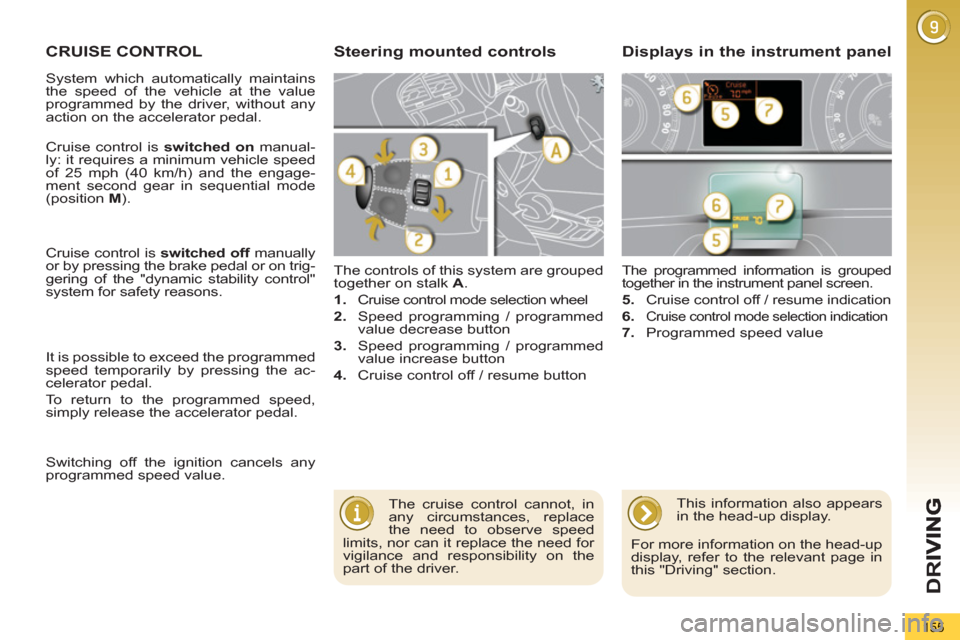
D
R
155
CRUISE CONTROL
The controls of this system are grouped
together on stalk A
.
1.
Cruise control mode selection wheel
2.
Speed programming / programmed
value decrease button
3.
Speed programming / programmed
value increase button
4.
Cruise control off / resume button The programmed information is grouped
together in the instrument panel screen.
5.
Cruise control off / resume indication
6.
Cruise control mode selection indication
7.
Programmed speed value
Steering mounted controls Displays in the instrument panel
The cruise control cannot, in
any circumstances, replace
the need to observe speed
limits, nor can it replace the need for
vigilance and responsibility on the
part of the driver.
Cruise control is switched on
manual-
ly: it requires a minimum vehicle speed
of 25 mph (40 km/h) and the engage-
ment second gear in sequential mode
(position M
).
Cruise control is switched off
manually
or by pressing the brake pedal or on trig-
gering of the "dynamic stability control"
system for safety reasons.
It is possible to exceed the programmed
speed temporarily by pressing the ac-
celerator pedal.
To return to the programmed speed,
simply release the accelerator pedal.
This information also appears
in the head-up display.
For more information on the head-up
display, refer to the relevant page in
this "Driving" section. Switching off the ignition cancels any
programmed speed value.
System which automatically maintains
the speed of the vehicle at the value
programmed by the driver, without any
action on the accelerator pedal.
Page 158 of 284
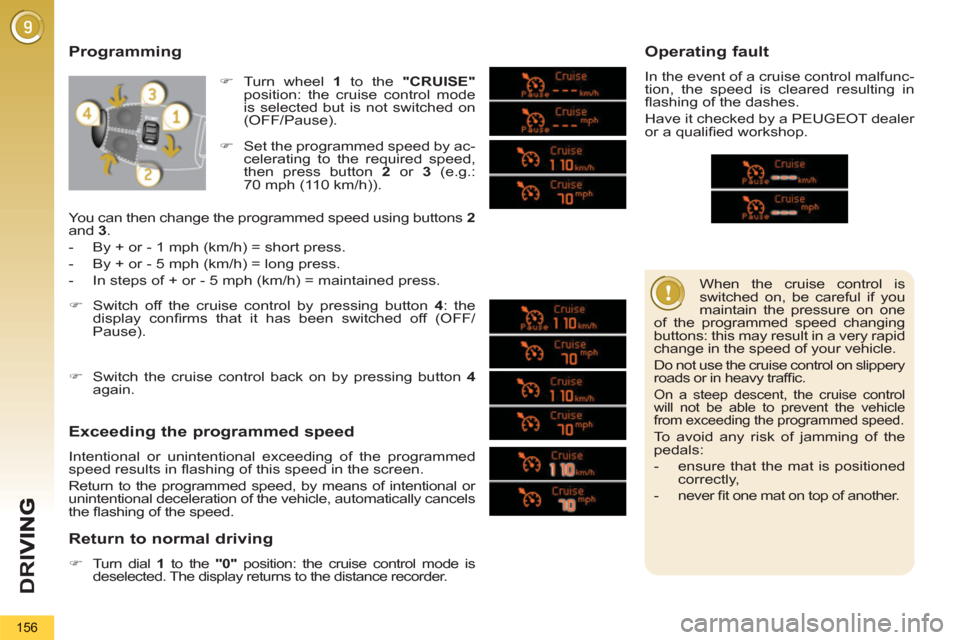
D
R
I
156
When the cruise control is
switched on, be careful if you
maintain the pressure on one
of the programmed speed changing
buttons: this may result in a very rapid
change in the speed of your vehicle.
Do not use the cruise control on slippery
roads or in heavy traffi c.
On a steep descent, the cruise control
will not be able to prevent the vehicle
from exceeding the programmed speed.
To avoid any risk of jamming of the
pedals:
- ensure that the mat is positioned
correctly,
- never fi t one mat on top of another.
Programming
Exceeding the programmed speed
Intentional or unintentional exceeding of the programmed
speed results in fl ashing of this speed in the screen.
Return to the programmed speed, by means of intentional or
unintentional deceleration of the vehicle, automatically cancels
the fl ashing of the speed.
Return to normal driving
�)
Turn dial 1
to the "0"
position: the cruise control mode is
deselected. The display returns to the distance recorder.
Operating fault
In the event of a cruise control malfunc-
tion, the speed is cleared resulting in
fl ashing of the dashes.
Have it checked by a PEUGEOT dealer
or a qualifi ed workshop.
�)
Set the programmed speed by ac-
celerating to the required speed,
then press button 2
or 3
(e.g.:
70 mph (110 km/h)).
�)
Switch off the cruise control by pressing button 4
: the
display confi rms that it has been switched off (OFF/
Pause).
�)
Switch the cruise control back on by pressing button 4
again.
You can then change the programmed speed using buttons 2
and 3
.
- By + or - 1 mph (km/h) = short press.
- By + or - 5 mph (km/h) = long press.
- In steps of + or - 5 mph (km/h) = maintained press.
�)
Turn wheel 1
to the "CRUISE"
position: the cruise control mode
is selected but is not switched on
(OFF/Pause).
Page 171 of 284
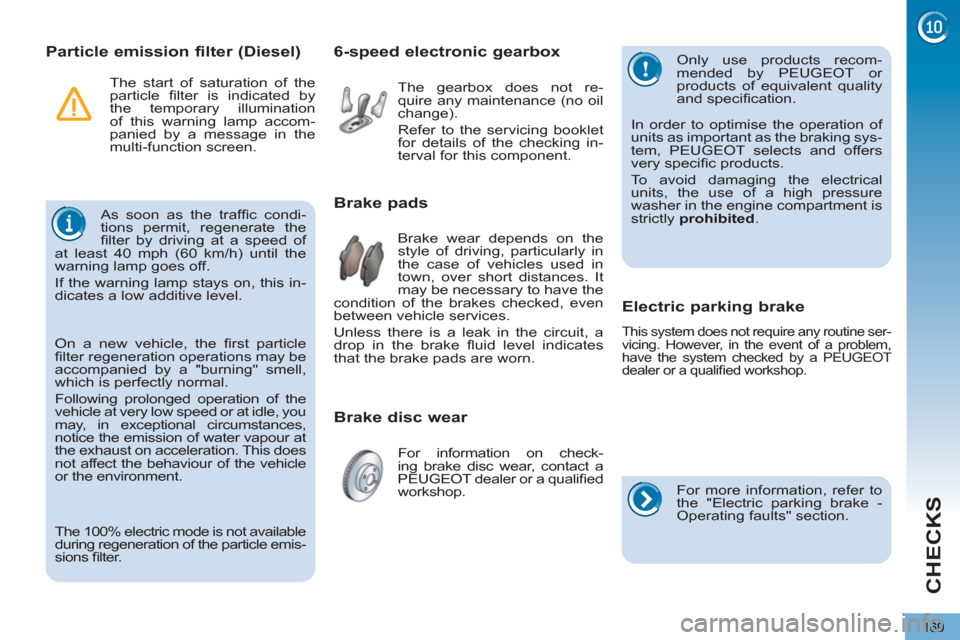
CHECKS
169
Particle emission filter (Diesel)
As soon as the traffi c condi-
tions permit, regenerate the
fi lter by driving at a speed of
at least 40 mph (60 km/h) until the
warning lamp goes off.
If the warning lamp stays on, this in-
dicates a low additive level.
Brake disc wear
Brake pads
Brake wear depends on the
style of driving, particularly in
the case of vehicles used in
town, over short distances. It
may be necessary to have the
condition of the brakes checked, even
between vehicle services.
Unless there is a leak in the circuit, a
drop in the brake fl uid level indicates
that the brake pads are worn.
For information on check-
ing brake disc wear, contact a
PEUGEOT dealer or a qualifi ed
workshop.
6-speed electronic gearbox
The gearbox does not re-
quire any maintenance (no oil
change).
Refer to the servicing booklet
for details of the checking in-
terval for this component.
Electric parking brake
This system does not require any routine ser-
vicing. However, in the event of a problem,
have the system checked by a PEUGEOT
dealer or a qualifi ed workshop.
For more information, refer to
the "Electric parking brake -
Operating faults" section.
The 100% electric mode is not available
during regeneration of the particle emis-
sions fi lter. The start of saturation of the
particle fi lter is indicated by
the temporary illumination
of this warning lamp accom-
panied by a message in the
multi-function screen.
On a new vehicle, the fi rst particle
fi lter regeneration operations may be
accompanied by a "burning" smell,
which is perfectly normal.
Following prolonged operation of the
vehicle at very low speed or at idle, you
may, in exceptional circumstances,
notice the emission of water vapour at
the exhaust on acceleration. This does
not affect the behaviour of the vehicle
or the environment.
Only use products recom-
mended by PEUGEOT or
products of equivalent quality
and specifi cation.
In order to optimise the operation of
units as important as the braking sys-
tem, PEUGEOT selects and offers
very specifi c products.
To avoid damaging the electrical
units, the use of a high pressure
washer in the engine compartment is
strictly prohibited
.